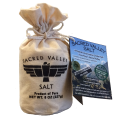Good Salt.
100% Responsible.
0% Hype.
Those are not empty words. Sacred Valley Salt is indeed good salt, and it's not hyped like many varieties of gourmet salt.
But what does "100% Responsible" actually mean? And what about that claim of it being "better than fair trade?"
We'll start off speaking in pretty broad terms, and then we'll get down to the nuts and bolts.
When you choose Sacred Valley Salt, your choice concretely and directly benefits the Sacred Valley and its inhabitants.

For Sacred Valley Trading Co., “100% Responsible” means treating the people involved in the production of Sacred Valley Salt fairly and with dignity, as well as treating the planet with respect. We will not sacrifice this principle for the sake of higher profits.

When it comes to the environment, Sacred Valley Salt could hardly have a lighter footprint. There is no excavation, pumping, heavy equipment, slag heaps, contaminated runoff, etc. All extraction and collection is done by solar and human power.

When it comes to people, Sacred Valley Trading Co. strives to make sure that local inhabitants of the Sacred Valley receive not only fair compensation for their salt, their work, and their skills, but also a fair share of the benefits from the sale of their unique resource.
For a foreign company that wants to export salt from the Sacred Valley, the simplest, most profitable approach would be to simply come in, set up shop, bring in their own management and hire local people to do the work. As long as the company pays fair wages and offers good working conditions, few would find fault with this approach. The company would indeed be benefitting the local community to some extent.
But Sacred Valley Trading Co. has gone a big step further. We’ve sought out independent local small businesses to partner with. We’ve negotiated on equal footing and worked out fair and mutually beneficial operating agreements. We’ve also provided some capital assistance to some of these partners to help them ramp up their capacity. On the other hand, we’ve stipulated that our partners must work to support the same principles that we actively uphold. For example, we require that they give hiring preference to single mothers and people with disabilities, (The Peruvian government offers very little social help for people in these situations) and that they pay good wages and offer clean, safe working conditions.
Better than Fair Trade???
How does this approach compare to Fair Trade? Fair Trade is a positive concept, and it has a commendable stated goal of helping producers in developing countries to achieve better trading conditions and promote sustainability. In practice, Fair Trade is highly decentralized and somewhat confusing, since there are so many different Fair Trade certifiers and so many different interpretations of what Fair Trade means. This has given rise to a lot of myths or mistaken assumptions about Fair Trade.
Let's have a look at how Fair Trade actually works. We'll use Sri Lankan tea as an example. (We can't use salt because there are no Fair Trade standards for table salt.)
Fair Trade Interactive Diagram
Click on an area of the diagram for an explanation of its role.
Importer/Packer
Per Fair Trade nomenclature, an importer/packer is a company in a developed country that imports a commodity from a developing country. Here we have a US tea company that imports tea from Sri Lanka.
Commodity Importation
The importer/packer imports a commodity from a developing country. In this case, the US tea company imports Fair Trade tea from Sri Lanka. The importer/packer purchases the tea from a Fair Trade certified producer. Generally the price is somewhat higher than tea's free market price.
Logo Licensing
The importer/packer pays the Fair Trade organization a licensing fee for permission to place the organization's Fair Trade logo on its product.
Fair Trade Organization
A Fair Trade labeling organization creates a Fair Trade Certification logo. The most widely recognized logo today comes from the non-profit Fair Trade International. Other Fair Trade labeling organizations exist as well, such as Fair Trade USA.
Finished Product Pricing
The tin of Fair Trade labeled tea sells for a higher price to consumers than other tea tins without the Fair Trade logo. This is known as the 'Fair Trade Premium.'
Brand Recognition
Due to the marketing efforts of Fair Trade organizations, their logos are readily recognizable to consumers. In the United States, for example, nearly half of consumers recognize the logo of Fair Trade USA, another leading Fair Trade organization.
Consumers
Consumers in developed countries often have the financial resources to voluntarily pay more for a product. Many such consumers for whom social and environmental issues are important are willing to pay a higher price for their tea. They expect that this price difference will help the tea producers to achieve a higher standard of living and practice sustainable cultivation methods.
Marketing
Fair Trade organizations market Fair Trade logos in developed countries worldwide.
Fair Trade Labeled Product
The importer/packer includes the Fair Trade logo on its product's packaging. The tea with the Fair Trade logo on the package can usually be sold for a higher price than equivalent tea without the logo. This higher price allows the importer/packer to recoup the higher price that it paid to the cooperative in Sri Lanka for the bulk tea.
FLO-CERT
FLO-CERT is a for-profit company that certifies and audits entities involved in Fair Trade. For a producer to become Fair Trade Certified, it must be audited for compliance by FLO-CERT. Thereafter, it is periodically audited for continued compliance.
Fair Trade Producer
A tea producer in Sri Lanka, often a cooperative, gets certified as a Fair Trade producer. As a Fair Trade producer, it must then meet certain criteria and standards laid out by Fair Trade labeling organization.
Marketing Expenses
The Fair Trade organization spends most of the proceeds from licensing their logo on marketing expenses.
Certification Fees
The prospective Fair Trade producer is responsible for paying certification and auditing fees to FLO-CERT. Some grants exist to assist small producers that don't have the resources to pay these fees.
Tea Purchase
When a consumer buys a Fair Trade labeled product, the Fair Trade Premium is divided among the entities shown in this diagram. Usually, only a few percent of this premium reaches the producer.
The basic idea, then, is that consumers in developed countries willingly pay a higher price for Fair Trade goods, and this higher profit works its way back to the actual producers in developing countries.
In a number of instances, this concept has had significant success, and producers from many cooperatives in developing lands speak positively of their involvement with Fair Trade. But several studies (some of which are distilled down in this article) have shown, however, that in most cases,
once the whole rather complex Fair Trade apparatus has paid for itself, there’s not much left over that actually makes it back to developing lands, particularly to the smaller, poorer producers.
At times, Fair Trade practices actually hurt producers in markets where rigid Fair Trade standards are inappropriate to a particular circumstance. Lack of transparency is a common complaint, and there have been numerous allegations of corruption within the Fair Trade system as well as failure to adequately monitor Fair Trade compliance among producers.
We’re not here to point fingers and find fault with the Fair Trade movement for its shortcomings. The sheer scale of the Fair Trade movement cannot realistically allow it to always work as intended, nor to work at a high level of efficiency. The Fair Trade organizations don’t have the luxury of just dealing with one single product from one single place, nor the flexibility to adapt their standards on a case-by-case basis to benefit individuals in developing lands. But at Sacred Valley Salt Co., we do have that luxury and that flexibility. Thus, we can achieve (and surpass) the same goals as Fair Trade without the parasitic effects of an administrative bureaucracy and an expensive marketing campaign, and we can directly monitor compliance with our core principles by our partners in Peru.
